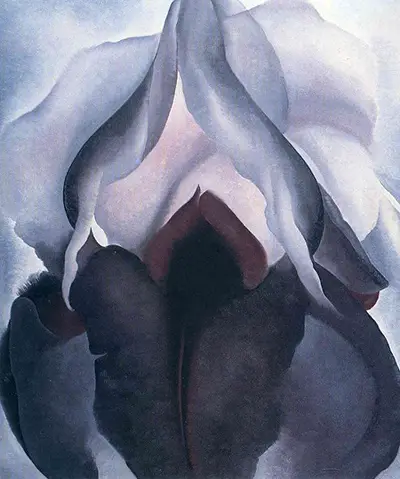The choice of Irises by O'Keeffe was no accident. This particular flower has symbolic use in religion in a similar way to the Tree of Life, as used by artists like Gustav Klimt. It is not believed likely that she was duplicating the symbolism from her Christian background, where it can be used to represent suffering and misfortune. Instead, it is probably just being used along the same lines as her other famous flower paintings such as Jimson Weed, Petunias and Oriental Poppies. It's inclusion could therefore be purely due to it's bright inherent colours and beautiful detail which the artist would always place a great emphasis upon, as well as whatever was growing well in her garden at the time. She planned which plants to grow based on what might work best within her work.
Female metaphors have long since been attributed to her work, but O'Keeffe always maintained that this was not the reason for her use of these items in her work. Symbolism can often be created by a viewer without the initial intention of the artist. Irises, particularly black Irises were inspiring to the artist over several years and are repeated across several paintings. She would also be able to pick them up locally in New York at certain times of the year and then make use of them in her popular high detail artworks. Whilst she liked to pick from her garden, some items would be harder to grow than others, and so she sometimes had to rely on other sources for her still life pieces. The secret to her success was her unique approach to composition, where individual flower heads would be large, showing the viewer their inner workings.
Black Iris was fairly early in the artist's approach to using flowers within her art. She wanted to force upon you the beauty of the inherent detail within a variety of species. It is perhaps a little similar to how Mark Rothko would produce huge canvases that were deliberately wider and taller than the viewer, making you feel like you were entirely immersed in his paintwork. Examples of that include Untitled (Violet, Black, Orange, Yellow on White and Red), No.3/No.13 (Magenta, Black, Green on Orange) and White Center, but Georgia O'Keeffe's take on this was obviously a little different because it relied on the detail of living things and was just zooming in on things that already existed. This also made her work a little more accessible than Rothko's because we can all grasp the content immediately, without any back story needed about what was intended by the artist. In our modern society, when everything is so fast paced, this can help to build a following with those less knowledgeable on contemporary art.
The artist's technique of enlarging flower heads to fill an entire canvas is taken to its limits within this composition, where there is almost nothing else in the scene at all. In some of her other paintings one might find leaves of the plant or a blue and white background showing through, but here we just have the various elements of this beautiful flower to see and study. Some consider it to be one of her early masterpieces and there have also been connections drawn with the female anatomy, though she always dismissed these claims and just encouraged viewers to see whatever they liked within these blown-up depictions. She also had a strong connection to the art of photography and this style of painting shows an understanding of working on images that go way beyond the natural sizes of different items. Her husband was also involved in photography and was known to have been shocked when she revealed the likes of Black Iris to him for the first time, perhaps excited at the opportunity to find buyers for these imaginative artworks.
The period of 1923-1927 would see a large number of flower paintings from this artist, including a number that could be considered amongst her most famous. O'Keeffe had several clear themes of work during her career, which she would focus on intensively before then moving onto something else. This productive period helped to esablish her as the best in this genre, certainly within the 20th century. Other notable examples can be found in the work of Albrecht Durer, many centuries earlier, who actually learnt his trade by studying his father's books on botany and would create copies of the illustrations of them in various watercolours and drawings of his own. He would keep this connection to nature throughout his career, but would also later make use of many other genres within his oeuvre as well. In terms of his botany studies, some of the better known examples included Great Piece of Turf, Iris and Iris Troiana.
